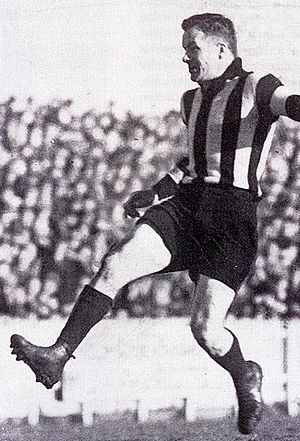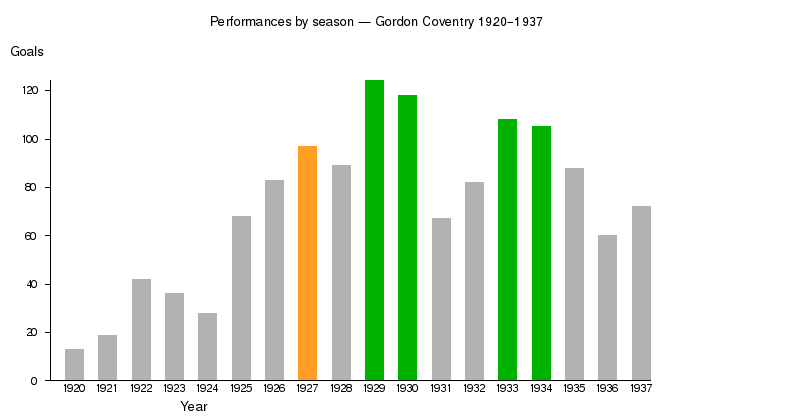Gordon Coventry facts for kids
Quick facts for kids Gordon Coventry |
|||
|---|---|---|---|
 |
|||
| Personal information | |||
| Full name | Gordon Richard James Coventry | ||
| Nickname(s) | "Nuts" | ||
| Date of birth | 25 September 1901 | ||
| Place of birth | Diamond Creek, Victoria | ||
| Date of death | 7 November 1968 (aged 67) | ||
| Place of death | Diamond Creek, Victoria | ||
| Original team | Diamond Creek | ||
| Position(s) | Full forward | ||
| Career highlights | |||
|
Club
Honours
|
|||
Gordon Richard James Coventry (born 25 September 1901 – died 7 November 1968) was a famous Australian rules footballer. He played for the Collingwood Football Club in the Victorian Football League (VFL).
Gordon Coventry is considered a "Legend" in the Australian Football Hall of Fame. He was the first player to reach 300 VFL games. He was also the first to kick 100 goals in a VFL season. He is the only player to be the league's top goal-kicker for five years in a row. Gordon was also the first player to kick 1000 VFL goals. His total of 1299 VFL goals was a record for over 60 years. Many fans and journalists think he is one of the best forward players ever.
Contents
Gordon Coventry's Family Life
Gordon Richard James Coventry was the eighth of ten children. His parents were Henry and Jane Coventry. His family called him "Nuts." Some say this was because he had a big head as a child. He was born on 25 September 1901 in Diamond Creek, Victoria.
Gordon's Marriage and Children
Gordon married Christabel Violet Lawrey on 28 February 1925. They had four children together. Their two sons were George Gordon and Graham. Their two daughters were Betty Lois and Margaret Shirley.
Gordon's Brothers and Their Lives
Gordon had several brothers. Three of them served in the First World War. John Thomas "Jack" Coventry and Thomas Coventry both served. Another brother, Hugh Norman "Oak" Coventry, sadly died in action in 1916. He was honored for his bravery as a stretcher bearer.
Syd Coventry: A Football Brother
Gordon's older brother, Sydney Andrew Coventry, also played for Collingwood. They played together for many years. Syd was a great player too. He won the Brownlow Medal in 1927. This award goes to the league's best and fairest player. Syd also captained Collingwood for many games. After playing, he became a coach and later a president for the club.
Gordon's Early Education
Gordon and his brothers and sisters went to Nillumbik State School. This school was in their hometown of Diamond Creek, Victoria. While still in school, Gordon started working on his father's fruit farm.
Gordon Coventry: A Powerful Footballer
Gordon Coventry was known for his strong and reliable kicking. He was great with his right foot. But he could also use his left foot very well when needed. He wasn't as flashy as some players. Instead, he was known for his incredible strength. He had a very strong grip when catching the ball. Once he got in front of a defender, he was almost impossible to stop. People said he rarely dropped a mark.
Starting at Diamond Creek Football Club
Gordon began his football journey at the Diamond Creek Football Club. This team was part of the Heidelberg District Football League (HDFL). He quickly became a top player there. In 1920, the Collingwood Football Club invited him to train with them. Collingwood was looking for new talent. Their star player, Dick Lee, was getting older and had injuries.
Gordon's Collingwood VFL Career
Gordon's VFL Debut Game
Gordon Coventry played his first senior game for Collingwood when he was 18. This was on 14 August 1920, against St Kilda. He played on the half-forward flank and kicked one goal. He showed good kicking skills. He played his second game on 4 September 1920. This was also Dick Lee's return game.
Gordon played in the semi-final and preliminary final that year. He even played in the 1920 Grand Final. Collingwood lost that game to Richmond. Gordon kicked 3 goals in the Grand Final.
Playing as a Half-Forward Flanker
In 1921, his second VFL season, Gordon was chosen for a special VFL team. This team was to play against a Bendigo team. However, he couldn't play because he had the flu. He played the entire 1922 season on one half-forward flank. He scored 42 goals that year. His brother, Syd, played on the other half-forward flank.
Becoming a Star Full-Forward
In 1923, Dick Lee retired. Gordon, who had already played 34 games, moved to the full-forward position. He became Collingwood's top goal-kicker that season with 36 goals. He quickly became one of the league's best and most consistent goal-kickers. In 1933, he won the Copeland Trophy. This award is for Collingwood's best and fairest player.
Gordon was Collingwood's top goal-kicker for 16 years in a row. He was also the league's top goal-kicker six times. Five of these were in a row, from 1927 to 1931. In 1927, he kicked Collingwood's only two goals in the 1927 VFL Grand Final. Collingwood won that game in very bad weather.
Gordon was the first player to kick 100 goals in a VFL season. He did this four times: in 1929, 1930, 1933, and 1934. In total, he kicked an amazing 1299 goals in VFL football. He also kicked 100 goals in VFL representative games.
Here are some of his amazing goal-kicking achievements:
- 9 goals in a Grand Final: He kicked 9 goals against Richmond in the 1928 VFL Grand Final. This is an unbeaten Grand Final record. Only Gary Ablett Sr. has equalled it.
- 10 goals in a match: He did this twice, in 1929 and 1933.
- 11 goals in a match: He achieved this five times between 1926 and 1931.
- 14 goals in a match: He kicked 14 goals against Hawthorn in 1934.
- 15 goals in a match: He kicked 15 goals against Essendon in 1933.
- 16 goals in a match: He kicked 16 goals against Hawthorn in 1929. This broke the old league record of 14 goals.
- 17 goals in a match: He kicked 17 goals against Fitzroy in 1930. This was a league record at the time. Only Fred Fanning has broken it (18 goals). Jason Dunstall has equalled it (17 goals).
Here are his season goal totals:
- 97 goals: 1927
- 105 goals: 1934
- 108 goals: 1933
- 118 goals: 1930
- 124 goals: 1929 (This was the first time any VFL player scored 100 goals or more in a season.)

Gordon's Finals Appearances
Gordon played in 31 finals matches during his 18-year career. This includes a drawn semi-final game in 1928. He played in 10 Grand Finals. Collingwood won five of these Grand Finals (1927, 1928, 1929, 1930, and 1935).
VFL Tribunal Incident
Gordon missed Collingwood's 1936 Grand Final victory. This was because he was suspended. It was the only time he was reported in his VFL career. He was found guilty of hitting Richmond player Joe Murdoch. Gordon had painful boils on his neck. When Murdoch repeatedly hit his neck, Gordon reacted.
Gordon was suspended for eight matches. Murdoch was suspended for four. Gordon tried to appeal the decision, but it was unsuccessful. At first, Gordon said he would retire from football. But he changed his mind. After serving his suspension, he played in 19 matches in 1937. He kicked 72 goals in his final VFL season.
Life Member of Collingwood
In 1932, Gordon was made a Life Member of the Collingwood Football Club. This is a special honor for long-serving members.
Gordon Coventry's Football Records
Gordon Coventry retired after the 1937 VFL season. He was the first player to play 300 VFL/AFL games. He won his sixth league leading goal-kicker award. He also won his 16th club leading goal-kicker award in a row. Coventry also played for Victoria 25 times, kicking 100 goals.
He was the first player to kick 100 goals in a VFL season. He did this in 1929, 1930, 1933, and 1934. He kicked a total of 1299 goals in VFL football. This record stood for over six decades. It was finally broken by Sydney Swans player, Tony Lockett, in 1999.
Gordon Coventry as a Coach
After leaving Collingwood, Gordon Coventry coached the Collegians team. This team played in the VAFA league for several years.
Gordon Coventry's Passing
Gordon Coventry passed away on 7 November 1968. He died from heart disease at his home in Diamond Creek. He was survived by his wife and four children.
Gordon Coventry's Lasting Legacy
In 2009, The Australian newspaper named Gordon Coventry as one of the 25 greatest footballers. These were players who never won a Brownlow Medal.
In 1996, Gordon Coventry was one of the first players inducted into the Australian Football Hall of Fame. Two years later, he was given "Legend" status. He was the fourteenth person to receive this honor.
In 1998, he was named as the full-forward in Collingwood's "Team of the Century". This means he was considered the best full-forward in the club's history.
On 24 November 1999, he was inducted into the Sport Australia Hall of Fame.
How Gordon Coventry is Remembered
The Gordon Coventry Trophy is awarded each year to Collingwood's top goal-kicker. The southern end of the Docklands Stadium is called the "Coventry end." Also, a gate at the MCG stadium is named after Gordon and his brother Syd.
See also
 In Spanish: Gordon Coventry para niños
In Spanish: Gordon Coventry para niños



